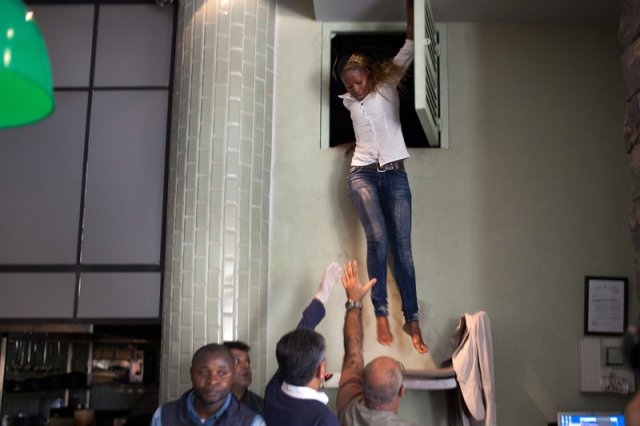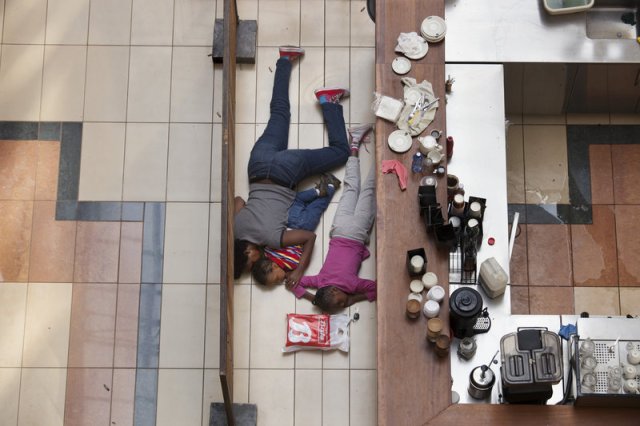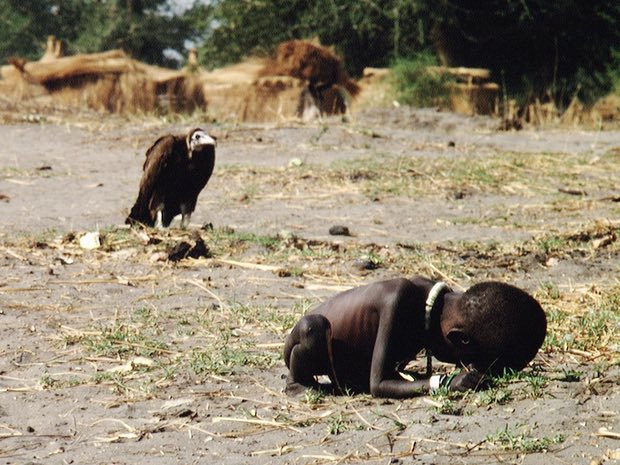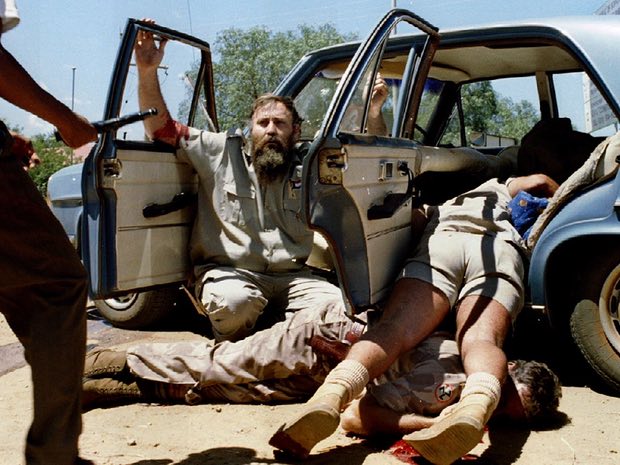Tyler Hicks is a photojournalist who won a Nobel Prize for his documentation of the 2013 attack on the Westgate Mall in Nairobi Kenya. Hicks was able to reconnect to the woman in his photograph after it won the Nobel Prize. After the attack began by islamic extremists at the mall Hicks rushed in to begin documenting the scene. Hicks was pleased he was able to Skype with the woman, because as a photojournalist more often than not they are not able to connect with those they have photographed. 

Author: daytonclark
Kevin Carter- Blog Post
Kevin Carter was a white South African photographer who worked during apartheid in South Africa as well as covering the famine in Sudan in the 1990’s. I first came across Carter in an installation about his life that I saw at the MCA Chicago. Unfortunately I couldn’t remember the artist’s name but the installation examined how Carter took a photograph of a starving child that incited a variety of reactions from the public, including a Nobel Prize but Carter committed suicide shortly after his Nobel Prize.
Carter’s life and suicide give us an extreme example of the suffering of war photographer’s having to cover tragedy repeatedly with little ability for intervention. Besides his Nobel Prize winning photo of the starving child in the Sudan, Carter also documented the tumultuous political climate of South Africa including a famous photograph of the shooting of a member of the Neo-Nazi Afrikaner Resistance Movement. Carter was often arrested by the South African government as his work went against their strict Apartheid-era laws. 

War/Photography Review- Reading Response
The NPR article reviews the exhibition War/Photography at the Corcoran Gallery in Washington in 2013. The exhibition exhibited photography dating back to the 1800’s and some of the most well-known photo’s including soldiers raising the flag and Iwo Jima and photographs from the Spanish Civil War. The author, Amaria, however describes the way the exhibition was curated by curator Anne Tucker as something that made it remarkable.
The exhibition is organized “in the order of war” according to curator Tucker. For example one part of the gallery was titled “Aftermath: Shell Shock and Exhaustion” which contained pictures going beyond the war into its aftermath. The images are therefore connected through patterns and themes not chronologically or by the war they were made during. Tucker wanted the exhibition to open up conversation between visitors by presenting the subject in such a different way than usual, and allowed a room for feedback from visitors entitled “Reflection.”
From the Fringes to the Frontline- Reading Response
The Guardian article by Melanie Abrams deals with the patriarchal views of war photography and profiles some female war photographers in order to challenge the usual view of war photography as a male only. Even though more and more female war photographers are appearing more and more, the field is still largely male dominated with only seven of 79 working at the Magnum photo agency being female.
Women photographers such as Jenny Matthews discuss not being taken as seriously as men but that having some advantage. Matthews said that while she was in Afghanistan in 1988 that “Even though the secret service was on our case, we were not taken seriously because we were women. It helped us get around and get our story.” The women in the article cite the experience of being a woman as sometimes being an obstacle but also that they were perceived as less threatening and used this to their advantage to capture inside shots. Photographer Susan Meiselas who covered the Nicaraguan civil war says that often people criticize female photographers for bringing in emotion into the work but that this is not necessarily a bad thing. “it was important to balance and feel the emotion. I was interested in multiple perspectives. The ethos of objectivity is an illusion.”
The Shot that Nearly Killed Me- Reading Response
In the Guardian article The Shot that Nearly Killed Me various well-known war photographers discuss some of their more famous and shocking photographs. The Photographers profiled chose images ranging from the siege of Sarajevo, war in the Congo, and in Afghanistan. Each photographer reflects on the difficulty of documenting war and the toll that can take on one’s psyche.
Photographer Alvaro Ybarra Zavala discusses a disturbing picture he made in the Congo in 2008. The picture is of a soldier with a knife in his mouth holding a hand that had been cut form someone’s body. Zavala discusses the fact that he wasn’t aware in the moment the danger he was in and just tried to act like he was a part of this crazy celebration of soldiers, and took the picture. He said he hates the photograph, as it shows the worst face of humankind, and still makes him feel frightened to this day. Like any photojournalist Zavara says he sometimes questions why he does what he does, and the answer is to show the best and worst of humankind and to provide documentation so future generations don’t repeat the mistakes of the past or forget.
Sontag Chap. 2- Reading Response
In chapter two of Regarding the Pain of Others, Susan Sontag explores the history of photojournalism specifically war photography. Photography was used to show the trench warfare on the Western Front and in WWI but The Spanish Civil War was some of the first moments of war captured by photojournalists in the field. Sontag of course discusses Robert Capa’s Fallen Soldier, one of the most famous and well-known photographs of war. She cites the shocking nature of this photograph, capturing the moment of a soldier being shot, as it’s reason for standing out in history.
In this chapter Sontag also discusses a photo exhibition that happened in New York after 9/11. Entries were open to anyone who had a photograph that they felt connected to the 9/11 attacks, creating an exhibition of amateur photographs that could be next to the work of a famous photographer but all were priced the same.
Photojournalism became such a primary source of reporting because images were able to create a lasting impression in people’s minds that text didn’t. It was perceived at first that a camera could capture a completely unbiased moment of truth but Sontag makes the argument that because there is someone behind the camera, photographs still have a strong point of view.
Memorial to the Murdered Jews of Europe- Reading Response
In a 2012 New Yorker article I came across titled “The inadequacy of Berlin’s memorial to the murdered Jews of Europe” the author Richard Brody gives a critique of the memorial and what he saw as its shortcomings. Brody takes issue with many things about the memorial beginning with the title. He questions if the memorial is intended for solely the victims of the Sho’ah or if this is meant to memorialize Jews that were murdered before the Holocaust throughout European history. Not having the Holocaust mentioned in the title Brody finds problematic, but I have seen the name of this memorial as tactful in focusing on the fact that this was murder and memorializing the Jewish people. Brody also takes issue with the somewhat casual placement of the memorial and how one can sit on the blocks, or children can play in them. And another issue is the fact that in the exhibition that exists under the memorial, the names of individuals are not mentioned unlike Yad Vashem.
These are the typical criticisms of this memorial and I feel them to be slightly short sighted. It is true that this memorial does not offer much information on what it is but I think its a powerful experience and something more effective than a traditional memorial. The memorial provides an immersive experience with minimalist aesthetics that seem appropriate to attempt to remember such an atrocity. Such a historically unique experience requires a unique approach to memorial design.
Reading response- Maus
The comic book/graphic novel Maus by Art Spiegelman examines the holocaust through the narrative of a survivor’s stories told by his son. The format of the novel is interesting in the temporality of the narrative as it switches between Vladek the father’s stories of his time in occupied Poland and in a concentration camp and present day Artie talking to Vladek. Artie goes over to his father’s house and interviews him about what he witnessed during the Holocaust. Through the switching narratives Maus examines how children of survivors are affected by their parent’s trauma and how the Holocaust has been remembered through survivor’s testimonies.
The choice to write Maus as a comic is an interesting stylistic choice and something the sounds bizarre and almost inappropriate before reading it. The result though is powerful and makes it easier to keep track of the switching narratives. The Jews are represented as mice and the nazis as cats. When Artie interviews his father he often gets frustrated when his dad gives him conflicting stories, or can’t remember certain details, and it illuminates the issue of memory in holocaust testimonies and how Holocaust history can be a blend of documentation and witness testimony.
Reading Response- Young End of the Monument
This chapter opens with the description of a proposal for the 1995 competition for a memorial for the murdered Jews of Europe in Berlin. Artist Horst Hoheisel proposed the unconventional idea of blowing up the Brandenburger Tor spreading the dust of the remains and covering them with granite plates. The idea was to decimate a part of German history to commemorate the decimation of an entire people by the Germans.
The chapter deals with the shift in the creation of monuments. Monuments have shifted in their construction and reflect the artistic environments, and have turned more and more to the reflection of a loss or absence by using negative space. We have seen this reflection of loss in Lin’s Vietnam Memorial and this chapter discusses Hoheisel’s response to a Jewish fountain that was destroyed in Kassel by the Nazis. Hoheisel’s monument to the Aschrott fountain is a mirror image of the old one “to rescue the history of this place as a wound.”
The chapter then discusses Rachel Whiteread’s Judenplatz Memorial in Vienna. The monument is a structure made of books but the spines are facing inwards. This memorializes the way that the events will never truly be understood by those who were not directly affected by the events, and also the Austrian Jewish writers and their contributions to Austria.
Young Antiredemptory- Reading Response
Young’s introduction deals with the issue of the post-holocaust generation of artists seeking to ‘remember’ this event even though they were not direct witness. Post-memory is a term used to describe the inheritance of memory, as each generation moves further away from the moment of witness. This generation of artists therefore uses a combination of history and memory to bear witness, as memory and fact work to support each other.
Artists and thinkers have dealt with the issue of representing the holocaust and how art representing the Holocaust has the danger of being in some way redemptory. The aesthetics must therefore address their own inadequacy in representation. Memorial artists in Germany have the challenge of representing the shame in the memorial landscape of the country, combining remembrance and self-indictment.
One of the memory-artists Young wishes to examine in the text is artist and author Art Spiegelman. Spiegelman wrote the famed “comix” Maus in which he interviewed his father and compiled a unique examination of the Holocaust through his father’s survival testimony and his own filtration of memory as a child of a survivor.
Representing the Holocaust poses a difficult and unique challenge as it would problematic for a memorial to be erected that sought to be redemptory in some kind
